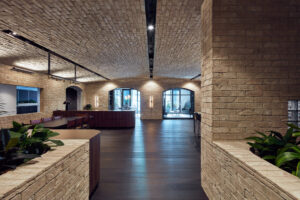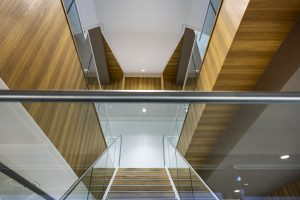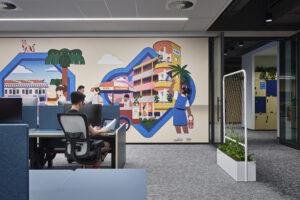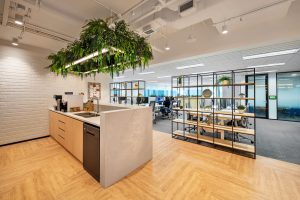Sustainable Office Design: Environmental and Business Benefits in 2025 .
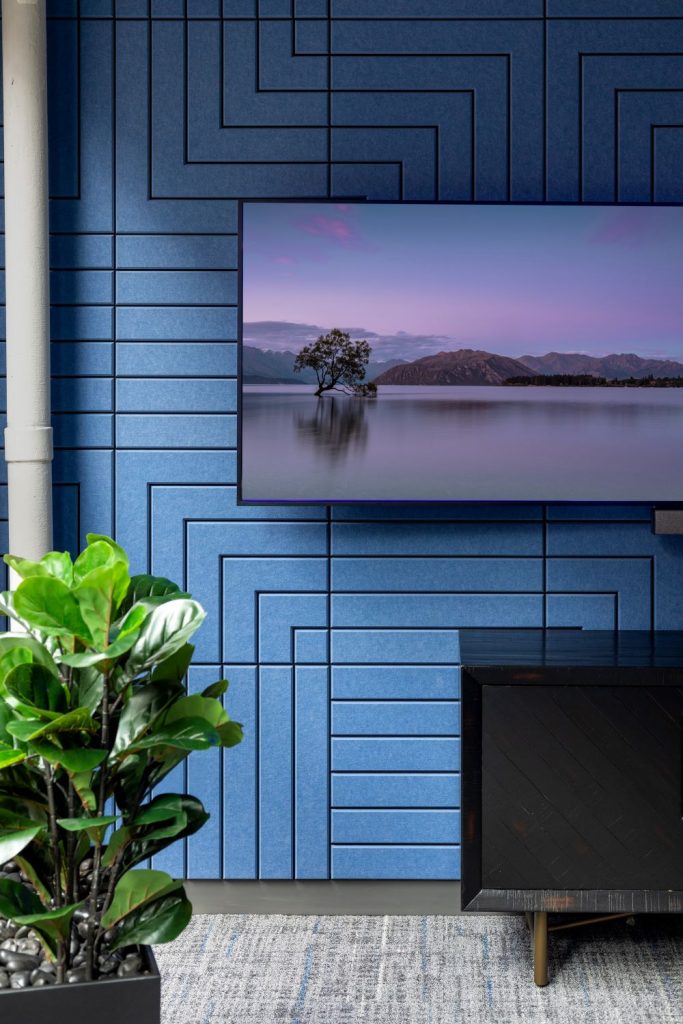
Sustainable Office Design: The Business Case for Green Building Practices in 2025
The landscape of sustainable office design has evolved from optional environmental consideration to essential business strategy in 2025. As organizations face increasing pressure to meet ESG (Environmental, Social, and Governance) objectives while controlling operational costs, green building practices have become critical drivers of competitive advantage. This comprehensive analysis explores how sustainable design principles deliver measurable environmental benefits while generating substantial business value through cost reduction, tenant attraction, and regulatory compliance in today’s environmentally conscious marketplace.
The Business Case for Sustainable Office Design
Sustainable office design represents a fundamental shift in how organizations approach workspace development, moving beyond cost minimization to value optimization through environmental stewardship. The business case for sustainability has strengthened significantly, with studies demonstrating that green building practices can reduce operating costs by 20-30% while improving tenant satisfaction and retention rates.
The integration of sustainability principles into office design reflects broader market trends toward environmental responsibility and corporate accountability. Organizations increasingly recognize that their physical environments directly impact their ability to attract talent, satisfy stakeholders, and meet regulatory requirements while supporting long-term business sustainability.
Modern sustainable office design encompasses energy efficiency, water conservation, indoor air quality optimization, waste reduction, and sustainable material selection. These elements work synergistically to create environments that support both human health and environmental protection while delivering measurable business benefits.
Market Demand and Competitive Differentiation
The demand for sustainable office spaces has reached unprecedented levels, with over 80% of corporate tenants actively seeking green building certifications when selecting office locations. This market shift has created competitive advantages for properties that embrace sustainability while placing conventional buildings at significant disadvantage in leasing markets.
ESG reporting requirements have further accelerated demand for sustainable office solutions, with companies needing to demonstrate environmental progress to investors, customers, and regulatory bodies. Sustainable office design enables organizations to meet these requirements while achieving operational efficiencies that support financial performance.
Energy Efficiency and Advanced Building Systems
Energy optimization represents the cornerstone of sustainable office design, with advanced building systems delivering both environmental benefits and substantial cost savings. Modern energy-efficient technologies can reduce building energy consumption by 40-60% compared to conventional systems while improving occupant comfort and productivity.
Smart HVAC and Climate Control Systems
Advanced HVAC systems utilize predictive analytics, occupancy sensors, and machine learning algorithms to optimize energy consumption while maintaining optimal indoor environmental conditions. These systems automatically adjust temperature, humidity, and air quality based on real-time occupancy patterns and external weather conditions.
Variable refrigerant flow (VRF) systems and high-efficiency heat pumps provide precise climate control while minimizing energy waste. Integration with building automation systems enables comprehensive optimization that coordinates lighting, HVAC, and other building systems for maximum efficiency.
LED Lighting and Daylight Harvesting
LED lighting systems integrated with daylight harvesting capabilities automatically adjust artificial lighting based on available natural light, reducing energy consumption by 50-75% compared to conventional lighting systems. Advanced controls enable zone-based management that optimizes lighting for specific activities and occupancy patterns.
Circadian lighting systems that adjust color temperature throughout the day support occupant health and productivity while maintaining energy efficiency. These systems demonstrate the integration of sustainable office design with human-centric design principles that benefit both environmental and business objectives.
Renewable Energy Integration
On-site renewable energy generation through solar panels, geothermal systems, and wind power enables buildings to achieve net-zero or net-positive energy performance. These systems often include battery storage capabilities that optimize energy usage and provide grid independence during peak demand periods.
Power purchase agreements (PPAs) for renewable energy enable organizations to access clean energy without significant capital investment while securing long-term energy cost stability. This approach supports ESG objectives while providing financial predictability that supports business planning.
Water Conservation and Management Systems
Water efficiency has become a critical component of sustainable office design, with advanced conservation systems reducing consumption by 30-50% while supporting broader environmental stewardship objectives. These systems often provide rapid return on investment through utility cost savings.
Advanced Plumbing and Fixture Systems
Low-flow fixtures, dual-flush toilets, and waterless urinals significantly reduce water consumption without compromising functionality or user experience. Sensor-activated faucets and fixtures eliminate waste while providing hygienic operation that supports health and safety objectives.
Greywater recycling systems capture and treat water from sinks and showers for use in irrigation and toilet flushing, further reducing municipal water demand while demonstrating environmental commitment to building occupants and visitors.
Rainwater Harvesting and Stormwater Management
Rainwater collection systems provide alternative water sources for irrigation and cooling systems while reducing stormwater runoff that can overwhelm municipal infrastructure. These systems often integrate with green building landscaping that supports biodiversity while reducing maintenance requirements.
Permeable paving and bioswales manage stormwater naturally while creating attractive outdoor spaces that enhance property aesthetics and environmental performance. These features demonstrate visible commitment to sustainability that supports tenant attraction and retention.
Indoor Air Quality and Health Optimization
Sustainable office design prioritizes indoor environmental quality that supports occupant health and productivity while reducing environmental impact. Advanced air quality management systems can improve cognitive performance by 15-25% while reducing sick building syndrome and associated productivity losses.
Advanced Filtration and Ventilation Systems
HEPA filtration systems and enhanced ventilation rates provide superior indoor air quality that exceeds standard building requirements. These systems are particularly important in post-pandemic environments where air quality has become a primary concern for office occupants.
Demand-controlled ventilation systems automatically adjust fresh air intake based on occupancy levels and indoor air quality measurements, optimizing both air quality and energy efficiency. Integration with building automation systems enables comprehensive environmental optimization.
Low-Emission Materials and Finishes
Green building practices emphasize materials and finishes with low volatile organic compound (VOC) emissions that support healthy indoor environments. These materials often provide superior durability and aesthetics while supporting environmental objectives.
Natural and recycled materials create attractive environments while demonstrating environmental commitment. Locally sourced materials reduce transportation impacts while supporting regional economies and creating unique design characteristics that differentiate properties in competitive markets.
Waste Reduction and Circular Economy Principles
Sustainable waste management has become integral to sustainable office design, with comprehensive programs reducing waste streams by 60-80% while supporting circular economy principles that minimize environmental impact.
Construction Waste Minimization
Sustainable construction practices emphasize waste reduction through precise planning, material optimization, and construction waste recycling. These approaches often reduce construction costs while supporting environmental objectives and ESG reporting requirements.
Modular construction and prefabrication techniques minimize on-site waste while improving construction quality and reducing project timelines. These methods support both sustainability and project efficiency objectives that benefit all stakeholders.
Operational Waste Management Systems
Comprehensive recycling programs, composting systems, and reuse initiatives minimize operational waste while educating occupants about environmental stewardship. These programs often generate cost savings through reduced waste disposal fees while supporting corporate sustainability initiatives.
Digital document management and paperless office systems eliminate significant waste streams while improving operational efficiency and information security. These technological solutions demonstrate how sustainability and business efficiency often align to create multiple benefits.
ESG Compliance and Reporting Benefits
ESG requirements have transformed sustainable office design from optional consideration to business necessity, with organizations needing to demonstrate environmental progress to investors, customers, and regulatory bodies. Sustainable office environments provide measurable data that supports comprehensive ESG reporting.
Environmental Impact Measurement
Advanced building monitoring systems provide detailed data on energy consumption, water usage, waste generation, and carbon emissions that support accurate environmental impact reporting. This data enables organizations to track progress toward sustainability goals while identifying opportunities for further improvement.
Third-party verification through green building certification programs such as LEED, BREEAM, and ENERGY STAR provides credible validation of environmental performance that supports ESG reporting and stakeholder communication.
Social and Governance Benefits
Sustainable office design supports social objectives through improved occupant health, comfort, and productivity while demonstrating governance commitment to environmental stewardship. These benefits often translate into improved employee satisfaction, retention, and recruitment outcomes.
Transparency in environmental performance and sustainability practices supports governance objectives while building trust with stakeholders including employees, customers, investors, and regulatory bodies.
Financial Benefits and Return on Investment
The financial benefits of sustainable office design extend beyond operational cost savings to include property value enhancement, tenant attraction premiums, and risk mitigation that support long-term investment returns.
Operational Cost Reductions
Energy and water efficiency measures typically provide 3-7 year payback periods while delivering ongoing cost savings throughout building lifecycle. These savings often exceed 20-30% of baseline operating costs while improving building performance and occupant satisfaction.
Reduced maintenance requirements for high-efficiency systems and durable sustainable materials provide additional cost savings while minimizing operational disruptions that can impact tenant satisfaction and retention.
Property Value and Market Premiums
Green building certifications typically increase property values by 5-15% while commanding rental premiums of 3-7% compared to conventional properties. These premiums reflect market demand for sustainable office spaces while supporting investment returns that justify sustainability investments.
Lower vacancy rates and higher tenant retention in sustainable buildings provide additional financial benefits through reduced marketing costs and improved cash flow stability that supports property financing and investment strategies.
Risk Mitigation and Regulatory Compliance
Sustainable design practices provide protection against regulatory changes, energy price volatility, and climate-related risks that could impact conventional buildings. This risk mitigation supports long-term property values while reducing operational uncertainties.
Future-proofing through sustainable design ensures buildings remain competitive as environmental regulations tighten and market expectations for sustainability continue rising. This forward-looking approach protects investment values while supporting business continuity.
Conclusion: Strategic Sustainability for Competitive Advantage
Sustainable office design represents a strategic opportunity for organizations to achieve environmental objectives while generating substantial business value through cost reduction, tenant attraction, and risk mitigation. As ESG requirements continue expanding and environmental awareness increases, sustainability has become essential for long-term business success rather than optional enhancement.
The integration of advanced technologies, high-performance systems, and sustainable materials creates office environments that support both environmental stewardship and business objectives while providing healthy, productive spaces that attract and retain high-quality tenants.
Success in this evolving landscape requires partnering with design professionals who understand both sustainability principles and business strategy, creating environments that deliver measurable environmental benefits while supporting financial performance and competitive positioning. As market expectations for sustainability continue rising, organizations that embrace comprehensive sustainable office design strategies will create lasting competitive advantages that support long-term success.
FAQs
What are the typical cost savings from sustainable office design?
How does green building certification impact property values and rents?
What ESG reporting benefits does sustainable office design provide?
How long does it take to see ROI from sustainable office design investments?
What sustainable features do tenants value most?
How does sustainable office design support talent attraction and retention?
What are the latest trends in sustainable office design for 2025?
How can organizations measure the success of their sustainable office design investments?
Sources and References
This analysis draws from leading sustainability research, green building organizations, and industry studies from authoritative sources:
Green Building Organizations and Standards
- U.S. Green Building Council (USGBC) LEED Research: LEED Environmental Impact Studies – https://www.usgbc.org/
- ENERGY STAR Portfolio Manager Benchmarking: EPA ENERGY STAR Research
- Building Research Establishment Environmental Assessment Method: BREEAM Sustainability Research
- International Living Future Institute: Living Building Challenge
Academic and Industry Research
- Harvard T.H. Chan School of Public Health COGfx Study: Cognitive Function and Green Buildings
- World Green Building Council Health, Wellbeing & Productivity: Green Building Health Benefits
- Rocky Mountain Institute Building Innovation: RMI Building Efficiency Research
- New Buildings Institute Zero Energy Research: Net Zero Energy Buildings
ESG and Sustainability Reporting
- Global Reporting Initiative (GRI) Standards: GRI Sustainability Reporting
- Sustainability Accounting Standards Board (SASB): SASB Real Estate Standards
- Task Force on Climate-related Financial Disclosures: TCFD Recommendations
- Carbon Disclosure Project (CDP): CDP Environmental Disclosure
Market Research and Industry Analysis
- JLL Global Real Estate Sustainability Research: JLL Sustainability Reports
- CBRE Global Real Estate Market Research: CBRE ESG and Sustainability
- Colliers International Sustainability Studies: Colliers Green Building Research
- Cushman & Wakefield ESG Research: C&W Sustainability Insights
Research compiled and analyzed as of September 2025. Sustainability practices and regulations continue evolving rapidly. For current implementation guidance and compliance requirements, consult with certified sustainability professionals and green building specialists.
